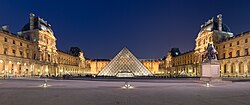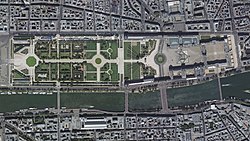Louvre
The Louvre is a museum in Paris. It has millions of visitors every year because of its art collection. It is the most visited art museum in the world.
| Musee du Louvre | |
|---|---|
 | |
| Established | 10 August 1793 |
| Location | Musée du Louvre, 75001 Paris, France |
| Type | Art museum and historic site |
| Visitor figures | 2.7 million (2020)[1]
|
| Director | Jean-Luc Martinez |
| Curator | Marie-Laure de Rochebrune |
| Public transit access | |
| Website | www.louvre.fr |
The most famous piece of art in the Louvre is the Mona Lisa by Leonardo da Vinci. Other paintings include works of Rembrandt, Giambattista Pittoni, Caravaggio, Rubens, Titian and Eugène Delacroix.
There are also many statues inside the Louvre. The most famous statues are the Venus de Milo and the Winged Victory of Samothrace.
History of the Louvre
Philip II of France built a castle called the Castle of the Louvre. It used to be where the museum is. They used the castle as a fortress to defend Paris against the Vikings. Charles V, King of France turned the castle into a palace. However, Francis I, King of France, knocked it down and built a new palace.
Henry IV, King of France added the Grande Galerie to the Louvre. The Grande Galerie is more than a quarter of a mile long and one hundred feet wide. The Grande Galerie was built along the River Seine. It was the longest building in the world.
The building was renovated during François Mitterand's time as French President. The glass pyramid and the inverted pyramid (made famous by The Da Vinci Code, a novel and later a movie) were the work of architect I.M. Pei.
Louvre Media
The display in the Salon Carré, painted by Giuseppe Castiglione in 1861 following its repurposing of the late 1840sVeronese's Wedding at Cana is visible on the left, and his Supper in the House of Simon (now at the Palace of Versailles) is on the right.
The Louvre's monumental Escalier Daru, topped by the Winged Victory of Samothrace, took its current appearance in the early 1930s.
Generalfeldmarschall Gerd von Rundstedt is seen with a plaster model of the Venus de Milo, while visiting the Louvre with the curator Alfred Merlin on 7 October 1940.
Seating designed by Pierre Paulin in the late 1960s, Grande Galerie
Marc Saltet's 1972 museography for the Salon Carré, with "dos-à-dos" seat designed in 1967 by Pierre Paulin
References
- ↑ "The Art Newspaper", 30 March 2021
- ↑ Rapport d'activité 2019 du musée du Louvre, p. 29, website www.louvre.fr.
Other websites
 Media related to Musée du Louvre at Wikimedia Commons
Media related to Musée du Louvre at Wikimedia Commons- Free photos of Louvre Archived 2008-06-23 at the Wayback Machine
- Fullscreen Virtual Tour by Virtualsweden Archived 2008-09-29 at the Wayback Machine
- History of the Louvre
- Excerpt of Michael T. Cannell's book on I.M. Pei — discusses controversy over Pei's pyramid.
- Official École du Louvre website Archived 2007-02-25 at the Wayback Machine (Requires Flash)








